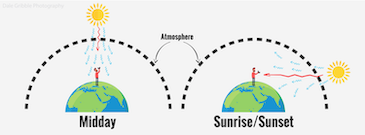Summit Eye Center Blog
Why are Sunsets Red?

Have you ever wondered why the sky is blue for most of the day, but at sunrise and sunset it has a red or orange hue to it? Maybe this is something that only we vision nerds think about. Either way, this week we hope to explain this phenomenon for you.
Light travels in waves. Like the ocean moves in waves to the shoreline, light travels in electronic and magnetic waves through the air. These waves of light come in various wavelengths. These different wavelengths represent different colors on the visible light spectrum. Think of the colors of a rainbow...maybe a good topic for a future blog. The shorter, higher energy waves are at the violet and blue end of the spectrum. The longer, lower energy waves are at the red and orange end of the spectrum.
The earth’s atmosphere, more simply the air we breathe, is made up of mostly two elements nitrogen (78%) and oxygen (21%). The remaining 1% of the atmosphere consists of dust, pollen, smoke, water vapor and trace gasses like argon. These particles that make up the atmosphere cause the light rays to scatter. The amount of scatter causes changes in the perceived color. Think of how the sky looks a different color when there is a lot of dust or smoke in the air.
 During most of the day the sky appears blue because the blue light of shorter wavelength is scattered the most, filling the sky with a blue color. At sunset, the sun is further away from us. Therefore, the blue light becomes nearly completely scattered to the point that it is washed out. The longer wavelengths at the red end of the visible light spectrum become more apparent then.
During most of the day the sky appears blue because the blue light of shorter wavelength is scattered the most, filling the sky with a blue color. At sunset, the sun is further away from us. Therefore, the blue light becomes nearly completely scattered to the point that it is washed out. The longer wavelengths at the red end of the visible light spectrum become more apparent then.
Now, you may ask...why do clouds appear white. Clouds are made of water vapor. Water vapor scatters light much more than nitrogen and oxygen, the main components of the atmosphere. Therefore, when light travels through the water vapor of clouds, it scatters all phases of the visible light spectrum from blue to red equally. This results in the white color of clouds.
The optical property of refraction is the technical term for the scattering or bending of the light rays. This is the same thing that your eye doctor or technician does when placing lenses in front of your eyes in an attempt to clear your blurry vision. These lenses of various powers bend the light to varying degrees, allowing it to come to a focal point on the retina in the back of your eye.
Refraction, bending of light, takes place when light passes through one medium into another. In the sky, this involves light traveling through outer space, then through the earth’s atmosphere, which has a different makeup.
In the eye, light first passes through the tear film, which coats the eye. This transition from the atmosphere to the tear film is the first step in focusing the light...this is why dry eye causes fluctuating or blurry vision. The light then passes through the cornea, the clear layer over the colored part of the eye. It then passes through the aqueous humor, which is the liquid that fills the front third of the eye. Then it passes through the pupil, the opening in the colored part of the eye...this is diffraction, a whole other topic for a later date. Next, it travels through the crystalline lens, as this lens clouds (the development of a cataract) light is scattered more. Then it travels through the vitreous, the jelly that fills the back two thirds of the eye. It then hits the retina. As you can see there are numerous steps within the eye where light is bent or focused, before hitting the retina.
Summit Eye Center specializes in maximizing the efficient and clear travel of light through our eyes to provide as clear of vision as possible for our patients. If you have any questions or would like an eye exam, call 816-246-2111 or email
